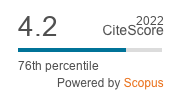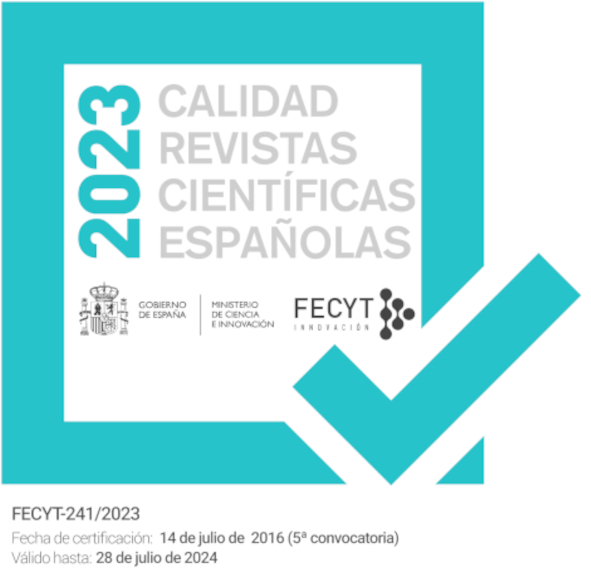Development and application of a multi-factorial sediment connectivity index at the catchment scale
DOI:
https://doi.org/10.18172/cig.1988Keywords:
sediment transport, geomorphological factors, connectivity index, check-dams, land use changes,Abstract
This paper presents a new methodology to assess sediment connectivity at the catchment scale. The proposed index CCI (Catchment Connectivity Index) is based on a combination of factors in a GIS environment that determine the connectivity of sediment in different elements (slopes, basins, channels) of the river system. The factors evaluated are the transport capacity on hillslopes (TC), check-dams’ trap efficiency (TE), the presence of geomorphological barriers (GF), flow conditions (FC) and the sediment transport capacity in channels (SP). This index was applied to estimate connectivity in the Upper Taibilla catchment (314 km2) (SE Spain) for different land use (1956 and 2006) and management (check-dams) scenarios. This catchment has suffered major land use and land cover changes over the last 50 years. The intense agricultural abandonment process and the implementation of soil erosion control measures (reforestation and check-dams) have strongly affected sediment dynamics of the basin. Calculation of the CCI allows identifying which landscape elements have most impact on the sediment (dis)connectivity at catchment scale. The results show a significant reduction in the connectivity of 76% between 1956 and 2006. However, it is observed that the check-dams contribute only 3% to this reduction. Land use changes had a much higher impact on reducing sediment connectivity, except in some areas with steep slopes, or with the development of agriculture along the main channels of the drainage network. Altogether, CCI showed to be a relatively easy and effective method that can be used for spatio-temporal sediment connectivity analyses in areas with natural and human disturbances.Downloads
References
Ambroise, B. 2004. Variable ‘active’ versus ‘contributing’ areas or periods: a necessary distinction. Hydrological Processes 18, 1149-1155.
Beguería, S., López-Moreno, J.I., Gómez-Villar, A., Rubio, V., Lana-Renault, N., García-Ruiz, J.M. 2006. Fluvial adjustments to soil erosion and plant cover changes in the Central Spanish Pyrenees. Geografiska Annaler, Series A: Physical Geography 88, 177-186.
Boix-Fayos, C., Barberá, G.G., López-Bermúdez, F., Castillo, V.M. 2007. Effects of check dams, reforestation and land-use changes on river channel morphology: Case study of the Rogativa catchment (Murcia, Spain). Geomorphology 91, 103-123.
Boix-Fayos, C., De Vente, J., Martínez-Mena, M., Barberá, G.G., Castillo, V. 2008. The impact of land use change and check-dams on catchment sediment yield. Hydrological Processes 22, 4922-4935.
Borselli, L., Cassi, P., Torri, D. 2008. Prolegomena to sediment and flow connectivity in the landscape: A GIS and field numerical assessment. Catena 75, 268-277.
Bracken, L.J., Croke, J. 2007. The concept of hydrological connectivity and its contribution to understanding runoff-dominated geomorphic systems. Hydrological Processes 21, 1749-1763.
Brierley, G.J., Fryi, K., Jain, V. 2006. Landscape connectivity: The geographic basis of geomorphic applications. Area 38, 165-174.
Brown, C.B. 1943. Discussion of Sedimentation in reservoirs, by J. Witzig. Transactions of the American Society of Civil Engineers 69, 1493-1500.
Cammeraat, L.H. 2002. A review of two strongly contrasting geomorphological systems within the context of scale. Earth Surface Processes and Landforms 27, 1201-1222.
Cantón, Y., Solé-Benet, A., de Vente, J., Boix-Fayos, C., Calvo-Cases, A., Asencio, C., Puigdefábregas, J. 2011. A review of runoff generation and soil erosion across scales in semiarid south-eastern Spain. Journal of Arid Environments 75, 1254-1261.
Coppus, R., Imeson, A.C. 2002. Extreme events controlling erosion and sediment transport in a semi-arid sub-andean valley. Earth Surface Processes and Landforms 27, 1365-1375.
De Vente, J., Boix-Fayos, C., Blas-Larrosa, J., González-Barberá, G., Castillo, V. 2007. Restauración Hidrológico-Forestal: Efectos Sobre el Ciclo Hidrológico. Cuenca Hidrográfica del Río Segura. Informe sobre la Clasificación de Usos del Suelo, LAI y Profundidad de Raíces, CEBAS, Murcia.
De Vente, J., Poesen, J., Verstraeten, G., Van Rompaey, A., Govers, G. 2008. Spatially distributed modelling of soil erosion and sediment yield at regional scales in Spain. Global and Planetary Change 60, 393-415.
Dietrich, W.E., Belligi, D.G., Sklar, L.S., Stock, J.D., Heimsath, A.M., Roering, J.J. 2003. Geomorphic transport laws for predicting landscape form and dynamics. Prediction in Geomorphology. Geophysical Monograph 135. American Geophysical Union, Washington, 30 pp.
Eastman, J.R. 2003. IDRISI Kilimanjaro Guide to GIS and Image Processing, Clark Labs, Worcester.
Faulkner, H., Alexander, R., Zukowskyj, P. 2008. Slope-channel coupling between pipes, gullies and tributary channels in the Mocatán catchment badlands, Southeast Spain. Earth Surface Processes and Landforms 33, 1242-1260.
Fryirs, K., Brierley, G.J. 1999. Slope-channel decoupling in Wolumla catchment, New South Wales, Australia: the changing nature of sediment sources following European settlement. Catena 35, 41-63.
Fryirs, K., Brierley, G.J. 2001. Variability in sediment delivery and storage along river courses in Bega catchment, NSW, Australia: implications for geomorphic river recovery. Geomorphology 38, 237-265.
Fryirs, K., Brierley, G.J. 2005. Practical application of the River Styles® framework as a tool for catchment-wide river management: A case study from Bega catchment, New South Wales, 230 pp.
Fryirs, K.A., Brierley, G.J., Preston, N.J., Kasay, M. 2007a. Buffers, barriers and blankets: The (dis)connectivity of catchment-scale sediment cascades. Catena 70, 49-67.
Fryirs, K.A., Brierley, G.J., Preston, N.J., Spencer, J. 2007b. Catchment-scale (dis)connectivity in sediment flux in the upper Hunter catchment, New South Wales, Australia. Geomorphology 84, 297-316.
Gallart, F., Balasch, C., Regüés, D., Soler, M. 2005. Catchment dynamics in a Mediterranean mountain environment: the Vallcebre research basins (South Eastern Pyrenees). II: Temporal and spatial dynamics of erosion and stream sediment transport. En Catchment Dynamics and River Processes: Mediterranean and other climate regions, C. García, R. Batalla (eds.), Elsevier, Amsterdam, pp. 17-28.
García-Ruiz, J.M., Lana-Renault, N., Beguería, S., Lasanta, T., Regüés, D., Nadal-Romero, E., Serrano-Muela, P., López-Moreno, J.I., Alvera, B., Martí-Bono, C., Alatorre, L.C. 2010.
From plot to regional scales: Interactions of slope and catchment hydrological and geomorphic processes in the Spanish Pyrenees. Geomorphology 120, 248-257.
Hancock, G.R., Coulthard, T.J. 2012. Channel movement and erosion response to rainfall variability in southeast Australia. Hydrological Processes 26, 663-673.
Hooke, J. 2003. Coarse sediment connectivity in river channel systems: a conceptual framework and methodology. Geomorphology 56, 79-94.
Hooke, J. 2006. Human impacts on fluvial systems in the Mediterranean region. Geomorphology 79, 311-335.
IGME 1980. Hojas de la Serie MAGNA 888 (Yetas), 899 (Yetas de Abajo), 909 (Nerpio) y 910 (Caravaca). Instituto Geológico y Minero de España, Madrid, 34 pp., 54 pp., 36 pp, 34 pp.
Kasai, M., Brierley, G.J., Page, M.J., Marutani, T., Trustrum, N.A. 2005. Impacts of land use change on patterns of sediment flux in Weraamaia catchment, New Zealand. Catena 64, 27-60.
Keesstra, S.D., Van Dam, O., Verstraeten, G., Van Huissteden, J. 2009. Changing sediment dynamics due to natural reforestation in the Dragonja catchment, SW Slovenia. Catena 78, 60-71.
Kirkby, M.J., Bracken, L., Reany, S. 2002. The influence of land use, soils and topography on the delivery of hillslope runoff to channels in SE Spain. Earth Surface Processes and Landforms 27, 1459-1473.
Lana-Renault, N. 2011. El efecto de los cambios de cubierta vegetal en la respuesta hidrológica y sedimentológica de áreas de montaña: la cuenca experimental de Arnás, Pirineo central. Consejo de Protección de la Naturaleza de Aragón, Zaragoza, 189 pp.
Lane S.N., Brookes, C.J., Kirkby, M.J., Holden, J. 2004. A network-index-based version of TOPMODEL for use with high-resolution digital topographic data. Hydrological Processes 18, 191-201.
Lesschen, J.P., Kok, K., Verburg, P.H., Cammeraat, L.H. 2007. Identification of vulnerable areas for gully erosion under different scenarios of land abandonment in Southeast Spain. Catena 71, 110-121.
López-Vicente, M., Poesen, J., Navas, A., Gaspar, L. 2013. Predicting runoff and sediment connectivity and soil erosion by water for different land use scenarios in the Spanish Pre-Pyrenees. Catena 102, 62-67.
McHug, M., Wood, G., Walling, D.E., Morgan, R., Zhang, Z., Anthony, S., Hutchins, M. 2002. Prediction of sediment delivery to watercourses from land, Phase II. R&D Technical Report no. P2-209, National Soil Resource Centre, Cranfield University, Cranfield.
Meerkerk, A.L., Van Wesemael, B., Bellin, N. 2009. Application of connectivity theory to model the impact of terrace failure on runoff in semi-arid catchments. Hydrological Processes 23, 2792-2803.
Michaeliodes, K., Wainwright, J. 2002. Modelling the effects of hillslope-channel coupling on catchment hydrological response. Earth Surface Processes and Landforms 27, 1441-1457.
Prosser, I.P., Rustomji, P. 2000. Sediment transport capacity relations for overland flow. Progress in Physical Geography 24, 179-193.
Quiñonero-Rubio, J.M., Boix-Fayos, C., Nadeu, E., de Vente, J. En revisión. Evaluation of the effectiveness of land use change and hydrological forest restoration works to reduce catchment sediment yield. Land Degradation and Development.
Reaney, S.M. 2008. The use of agent based modelling techniques in hydrology: determining the spatial and temporal origin of channel flow in semi-arid catchments. Earth Surface Processes and Landforms 33, 317-327.
Reaney, S.M., Bracken, L.J., Kirkby, M.J. 2007. Use of the Connectivity of Runoff Model (CRUM) to investigate the influence of storm characteristics on runoff generation and connectivity in semi-arid areas. Hydrological Processes 21, 894-906.
Sandercock, P.J., Hooke, J.M. 2011. Vegetation effects on sediment connectivity and processes in an ephemeral channel in SE Spain. Journal of Arid Environments 75, 239-254.
Sougnez, N., Van Wesemael, B., Vanacker, V. 2011. Low erosion rates measured for steep, sparsely vegetated catchments in southeast Spain. Catena 84, 1-11.
Van Oost, K., Govers, G., Desmet, P.J.J. 2000. Evaluating the effects of changes in landscape structure on soil erosion by water and tillage. Landscape Ecology 15, 577-589.
Van Rompaey, A. J.J., Verstraeten, G., Van Oost, K., Govers, G., Poesen, J. 2001. Modelling mean annual sediment yield using a distributed approach. Earth Surface Processes and Landforms 26, 1221-1236.
Verstraeten, G., Van Oost, K., Van Rompaey, A., Poesen, J., Govers, G. 2002. Evaluating an integrated approach to catchment management to reduce soil loss and sediment pollution through modelling. Soil Use and Management 19, 386-394.
Verstraeten, G., Prosser, I.P., Fogarty, P. 2007. Predicting the spatial patterns of hillslope sediment delivery to river channels in the Murrumbidgee catchment, Australia. Journal of Hydrology 334, 440-454.
Vigiak, O., Borselli, L., Newham, L.T.H., McInnes, J., Roberts, A.M. 2012. Comparison of conceptual landscape metrics to define hillslope-scale sediment delivery ratio. Geomorphology 138, 74-88.
Walling, D.E. 1983. The sediment delivery problem. Journal of Hydrology 65, 209-237.
Downloads
Published
How to Cite
Issue
Section
License
The authors retain copyright of articles and authorize Cuadernos de Investigación Geográfica / Geographical Research Letters the first publication. They are free to share and redistribute the article without obtaining permission from the publisher as long as they give appropriate credit to the editor and the journal.
Self-archiving is allowed too. In fact, it is recommendable to deposit a PDF version of the paper in academic and/or institutional repositories.
It is recommended to include the DOI number.
This journal is licensed under a Creative Commons Attribution 4.0 International License











